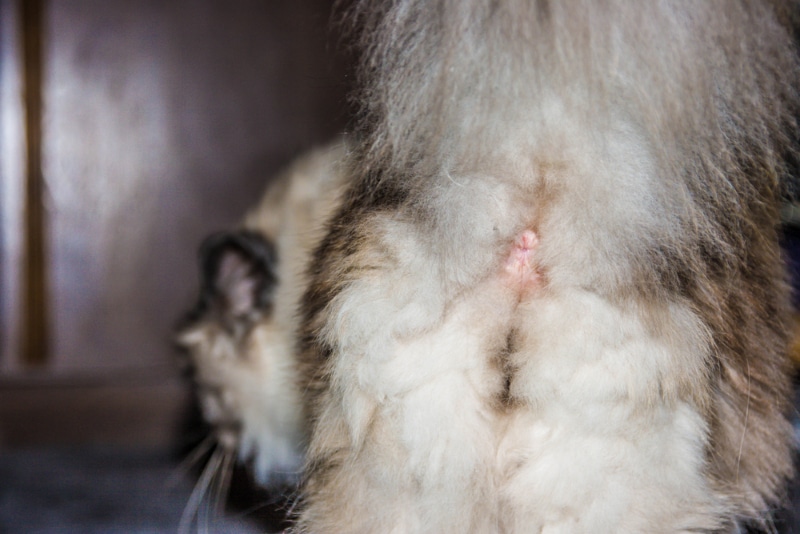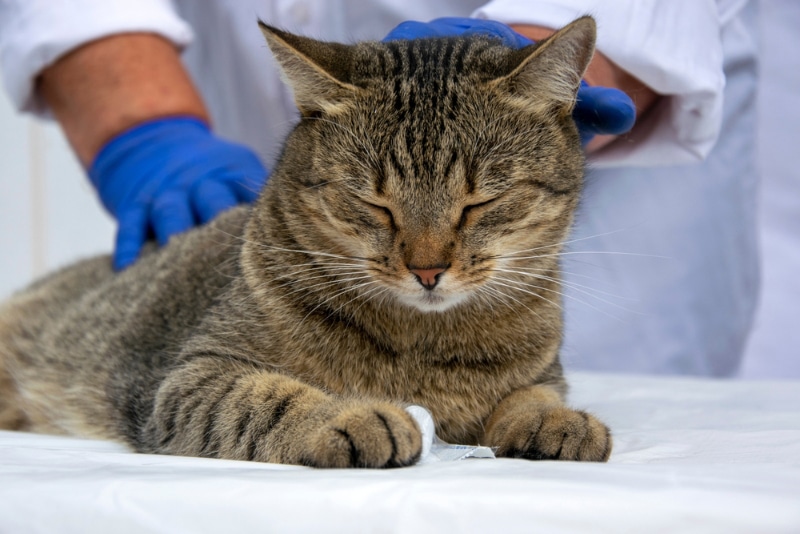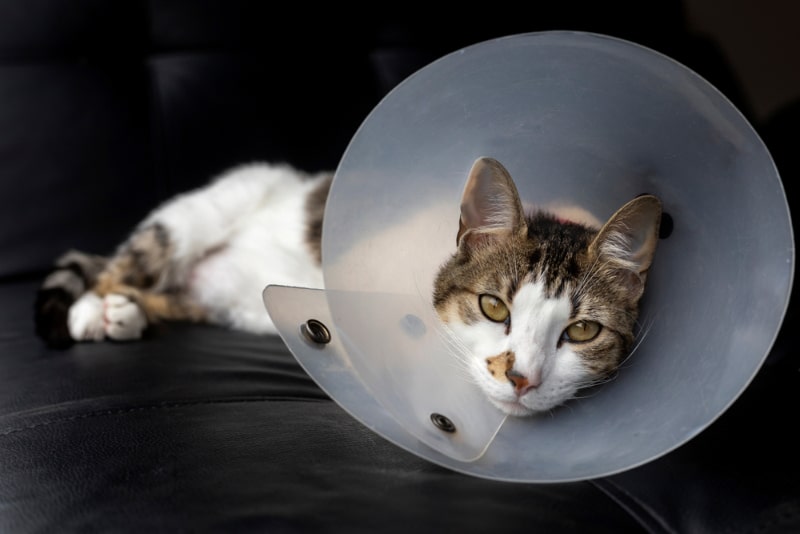A few of our readers could also be acquainted with anal sacs as a standard source of irritation in dogs, but did you already know that cats can suffer from anal gland problems as well? Excessive licking, smelly discharge, a sore bottom, and scooting are common signs that your cat could also be experiencing anal gland issues.
In the next article, we’re going to take a more in-depth have a look at how one can recognize and treat anal sac disease in cats, in addition to some common problems that may additionally give our feline friends an actual pain within the behind.
Click Below to Jump Ahead:
What Are Anal Sacs?
The terms “anal sac” and “anal gland” are sometimes used interchangeably, but this is just not technically accurate. The anal sacs, that are small, blind-ending structures that sit on either side of the anus, are lined with anal glands, which produce the fluid that you simply could be acquainted with. This fluid, just like that produced by skunks, can sometimes smell fishy, fetid, or foul to us, but to our pets, it is definitely crammed with information.
Have you ever ever wondered why cats and dogs appear to be so concerned with having an excellent sniff of one another’s bottoms, in addition to what comes out of them? What they’re actually sniffing is the fluid produced by the anal glands. The glands lining the anal sac are a form of modified sebaceous (sweat) gland that produces a fluid that’s full of pheromones—the olfactory equivalent of a social media profile.
When your cat passes feces, these sacs are squeezed, releasing a small amount of this fluid onto their poop. Other cats that smell this will get an idea of the reproductive status, social standing, and health of the feline in query, and there could also be many other messages that this fluid can relay.
Image Credit: Pashu Ta Studio, Shutterstock
What Causes Anal Sac Disease?
The principal explanation for anal sac disease, also often known as anal sacculitis, is impaction. This could occur if the duct that drains the sac is just too narrow to permit fluid to exit, which is a more common issue in dogs. In cats, weight loss plan is the standard perpetrator, with soft stools resulting in incomplete emptying of the glands. Over time, the fluid accumulates, dries out, and becomes even tougher to specific. The result’s a big, firm gland that makes pooping tougher, in addition to making sitting quite uncomfortable.
In case your cat has had a bout of diarrhea or tends to supply small, soft stools, they could be susceptible to developing impacted anal sacs, as there must be pressure generated while defecating with a purpose to naturally empty them.
Cats which can be stressed or surrounded by numerous cats, whether or not they are sharing their home or in the realm outside, can often find yourself producing an excessive amount of anal gland fluid as their body tries to send a passive-aggressive message to the opposite felines in the realm. This may also make them more prone to experience an anal sac impaction.
Anal sacs may also grow to be infected, with abscesses forming inside the glandular tissue. This could occur because of this of impaction but may also occur by itself. Although rare in cats, anal sac tumors may also occur.
How Is Anal Sac Disease Treated?
Within the case of anal sac impaction, your veterinarian will manually empty the sacs by squeezing them with their fingers. This generally is a reasonably unpleasant experience, but one which is often over with quickly. In case your cat is in pain or particularly uncooperative, they could have to be sedated.
If the sac is infected, your cat might want to take antibiotics, and the sac or abscess may have to be flushed under a general anesthetic. They may also be given anti-inflammatory pain relief as they get well.
In case your vet suspects a tumor, they may must take a tremendous needle biopsy to verify the diagnosis. Tumors could be surgically removed, and if done so early, removal is commonly curative.
Image Credit: Helen-HD, Shutterstock
What Are the Signs of Anal Sac Disease?
The principal signs of anal sac disease are:
- Excessive licking of and across the anus.
- Very smelly bottom or fluid. You would possibly notice this in an area where your cat has been sitting and sleeping.
- Painful bottom. Sometimes cats will jump up as in the event that they have been bitten, yowl when going to the bathroom, or be grumpy or aggressive, particularly when touched near the back end
- That is less common in cats than in dogs and is the classic dragging of the underside along the ground in an try and get relief from the pressure contained in the sacs
Impaction, Infection, or Tumor?
Only your vet can properly diagnose anal sac disease in your cat, but as a basic rule of thumb:
- Anal sac impaction is often bilateral, with minimal external signs.
- Anal sac infection is often unilateral, and you may often see redness or swelling next to the anus on one side. The abscess may rupture, causing a sinus or hole within the skin that blood and pus drain out of. Anal sac infection is commonly quite painful but normally feels higher once the abscess has ruptured.
- Anal sac tumors are likely to be less painful, but you might have the ability to see some swelling beside the underside. They may also be unilateral.
Because cat bottoms are frequently quite fluffy, it could possibly be difficult to inform the difference, so it is best to all the time make an appointment together with your vet in case your cat starts showing signs of bottom discomfort or pain.
How Can I Prevent Anal Sacculitis?
Being that the leading explanation for anal sacculitis is impaction or blockage, crucial technique to avoid this case is by having well-formed, firm stools. Small, soft feces is not going to exert pressure on the sacs, resulting in the buildup and drying of the fluid, which, as we all know, is how these sacs grow to be blocked.
Cats on a high-quality weight loss plan rarely experience issues with their anal sacs, as their stools are likely to be of excellent quality. Cats fed lower-quality foods, or people who suffer from sensitive digestive systems, usually tend to suffer from anal sacculitis.
An important thing we are able to do to assist our cats avoid this painful problem is to:
- Discuss with your vet about what could be causing your cat’s anal sac issues.
- Feed your cat a high-quality weight loss plan that leads to nice, firm stools.
- Consider adding fiber into the weight loss plan to assist improve the standard of their stools, especially in case your cat is liable to anal sac disease or inflammatory bowel issues. Small amounts of pumpkin generally is a tasty technique to achieve this, or there are plenty of several types of high-fiber foods or supplements that may also help keep your kitty regular, in addition to reduce the formation of hairballs.
Often Asked Questions (FAQs)
Do Cats Need Their Anal Sacs Emptied Commonly?
No. Unless your cat is showing signs of anal sac problems, they’re best left alone. Cats which have a history of anal sac issues will profit from regular checkups to see in the event that they need emptying, but this needs to be done by your vet.
Can Cats Have Their Anal Sacs Removed?
Surgical removal of the sacs, or anal sacculectomy, is a procedure only used when absolutely needed (i.e., within the case of tumors), or when recurrent anal sac problems are negatively impacting their quality of life. Since the anal sacs are situated very near the muscles and nerves that control the anal sphincter, damage to those structures could end in fecal incontinence. Surgical removal of the feline anal sacs also poses a risk of damaging the wall of the rectum.
Image Credit: amilciar, Shutterstock
What Are Some Other Conditions of the Feline Bottom?
In case your cat is spending an unusual period of time tending to their bottom area, there are a couple of other conditions that try to be aware of.
- Rectal strictures: Formed by scar tissue or membrane adhesions within the rectal lining, these can create narrowed areas inside the rectum. More often than not, they’re fairly harmless, but you would possibly notice some fresh blood in your cat’s poop occasionally. In additional serious cases, defecation can grow to be painful. These cases are frequently managed with weight loss plan modification and pain relief.
- Urinary tract disease: Infection or inflammation of the bladder or urethra may end up in excessive licking and grooming of the genital area, in addition to increased visits to the litter box, straining, or toileting outside the box.
- Rectal prolapse: Normally attributable to excessive straining, this will result from chronic diarrhea, constipation, intestinal worms, or neoplasia (cancer). The motion of straining causes swelling of the rectal lining and eventually results in probably the most distal a part of the rectal tissue being pushed out the anus. That is an emergency and, even with prompt treatment, can grow to be a recurrent problem.
Final Thoughts
While cats are frequently fastidious about being clean, spending an unusual period of time focused on the behind could possibly be an indication of anal sac disease. Your cat needs to be examined by a vet in the event that they are showing any of the above signs of bottom discomfort. Typically, a squeeze of the anal sacs will solve the difficulty, but often, a change in weight loss plan is so as. There are some more serious issues that could cause your feline to give attention to their behind, all of which need assistance out of your vet.
Fortunately, more sinister kinds of anal sac disease are relatively rare in cats. In case your cat suffers from anal sac issues, seek advice from your vet about what you may do to enhance the situation. A high-quality weight loss plan with a healthy fiber source to advertise firm, formed feces is the very best technique to avoid issues with these scent glands and stop your feline from affected by pain of their bottom.
Featured Image Credit: Dina Photo Stories, Shutterstock





